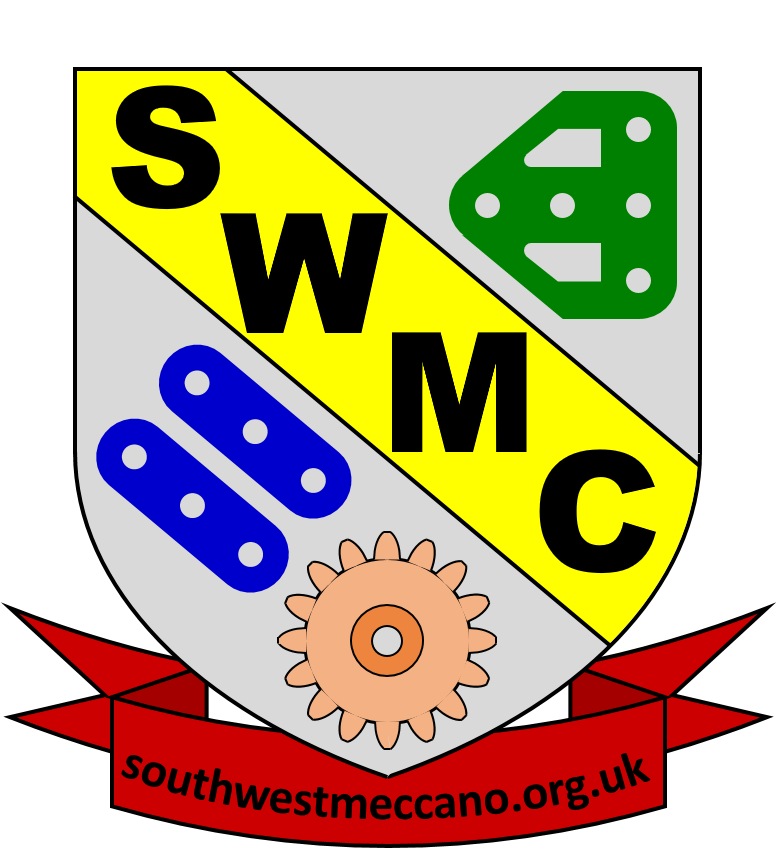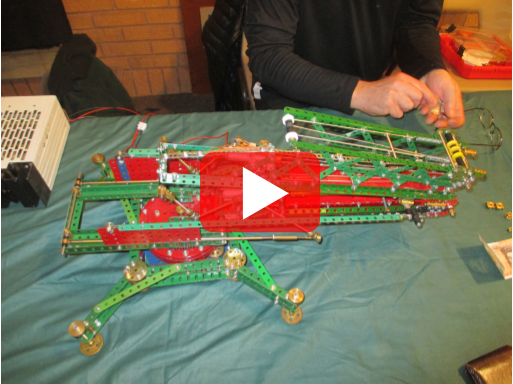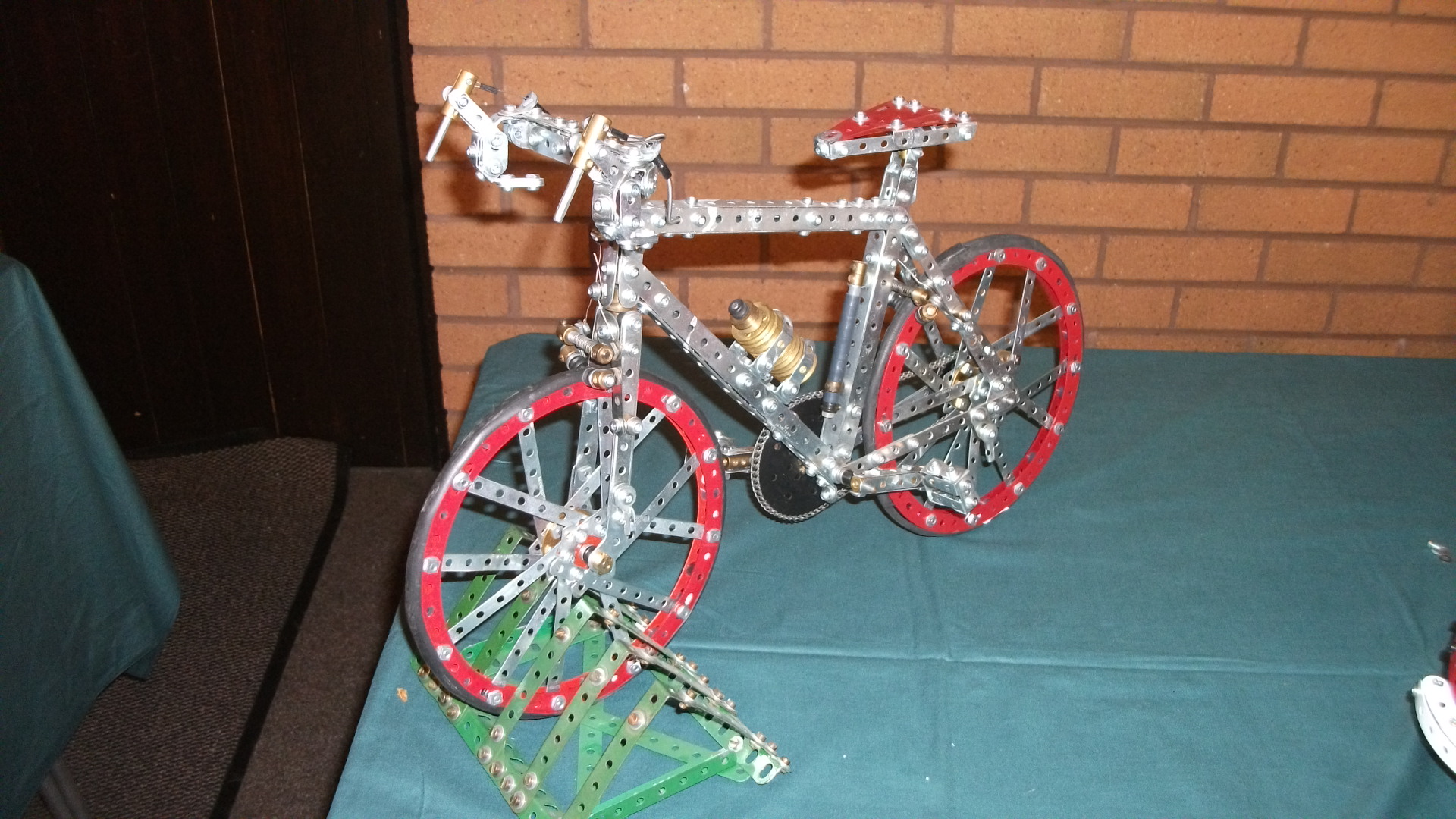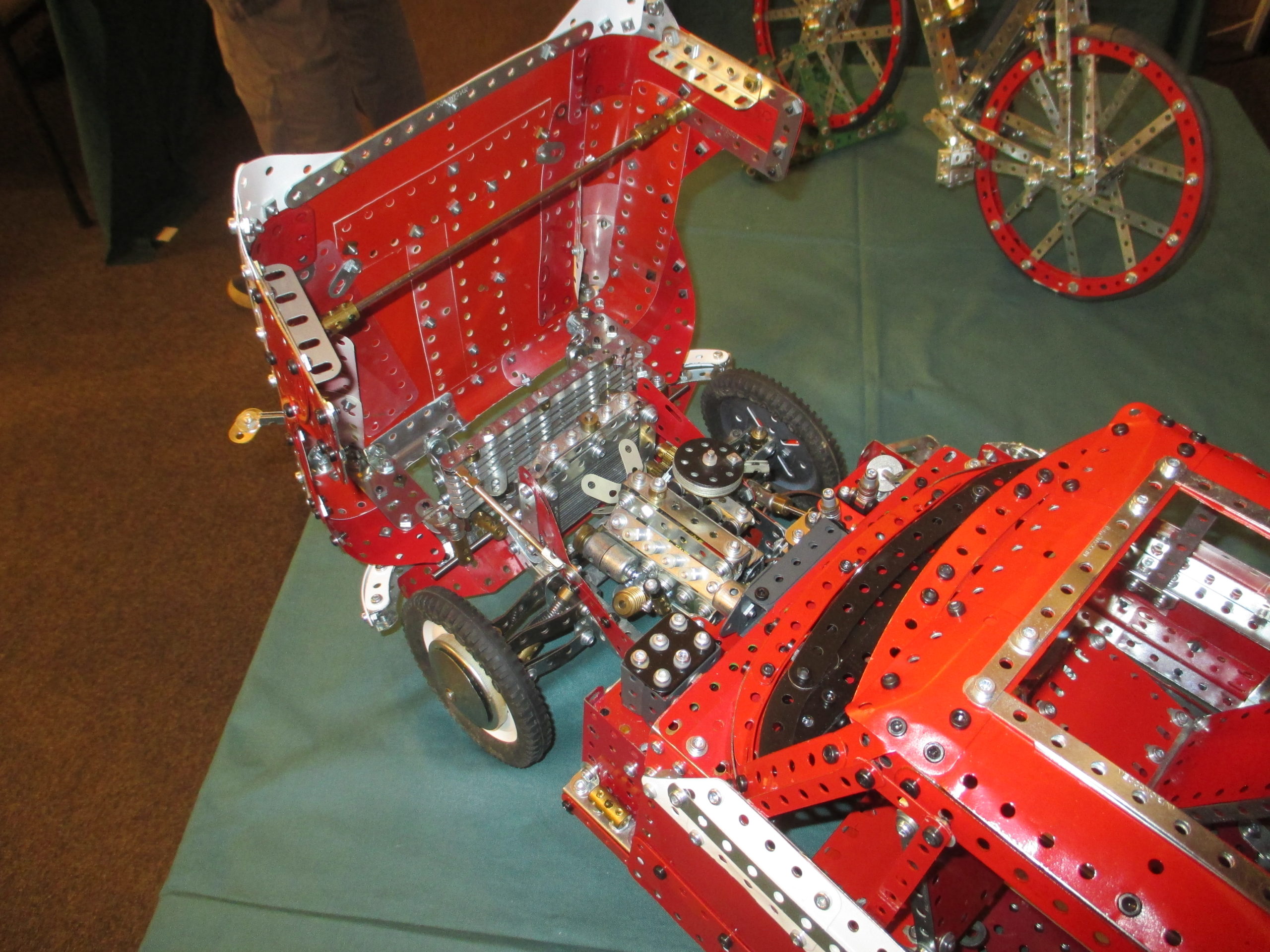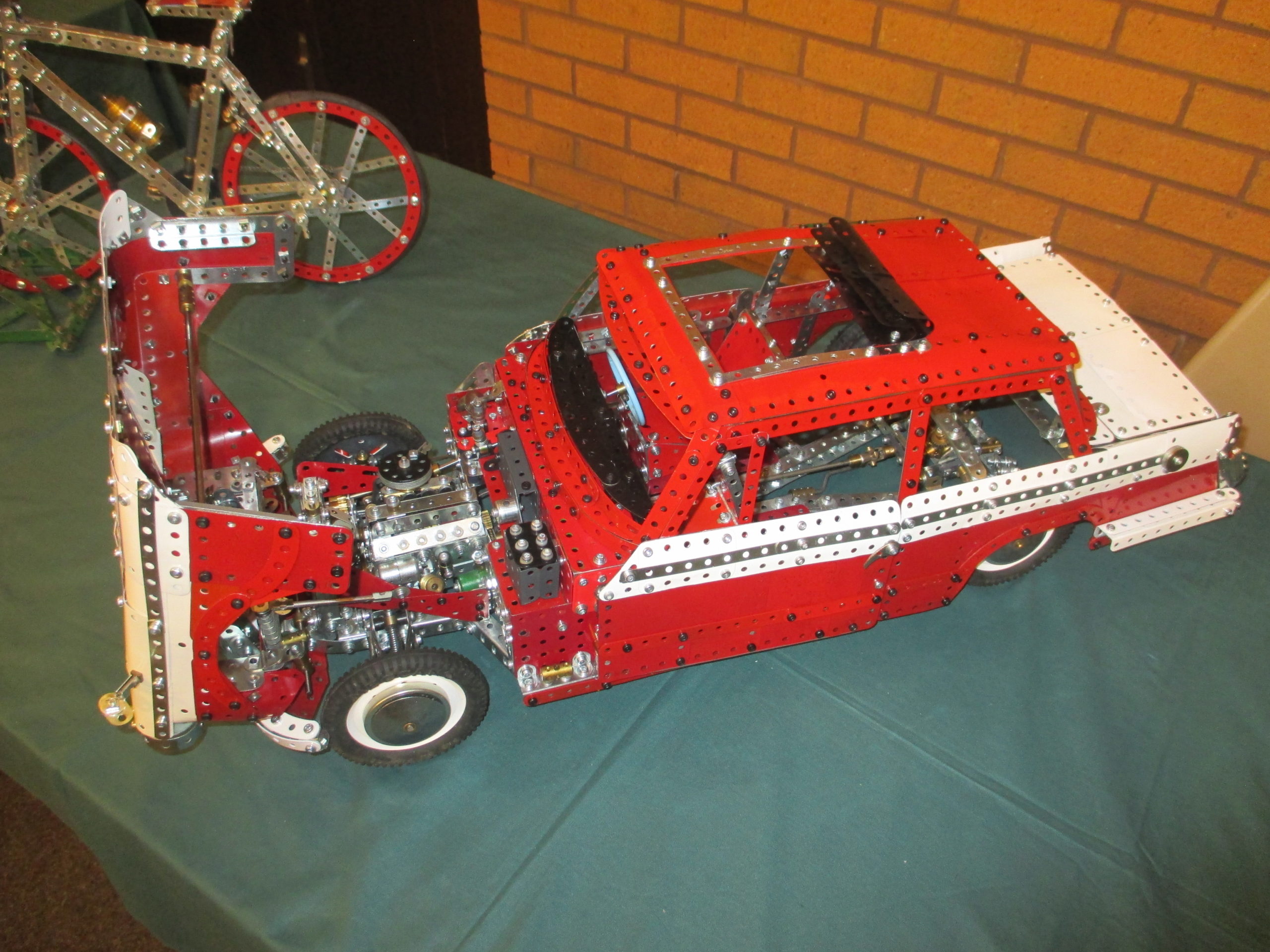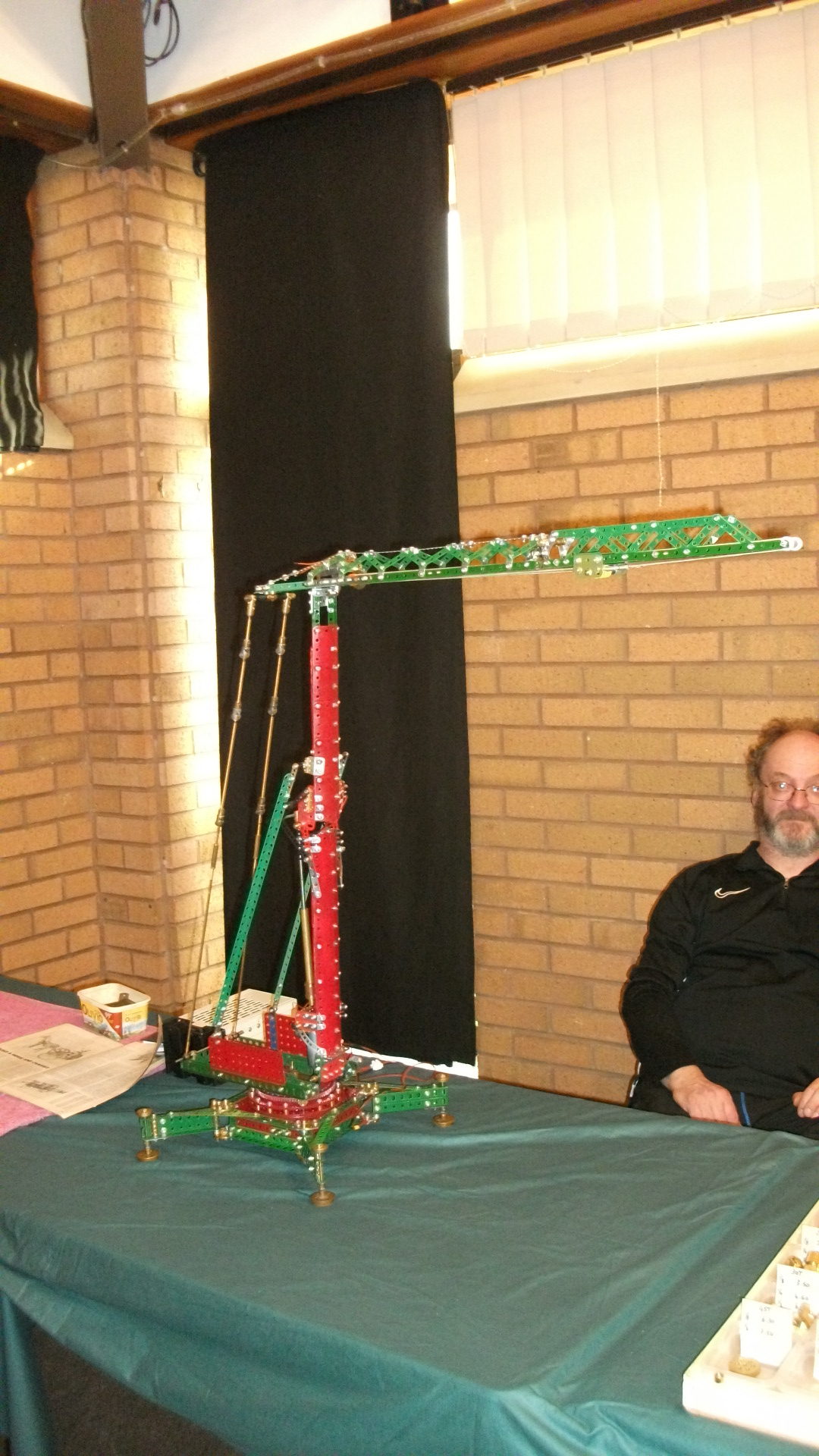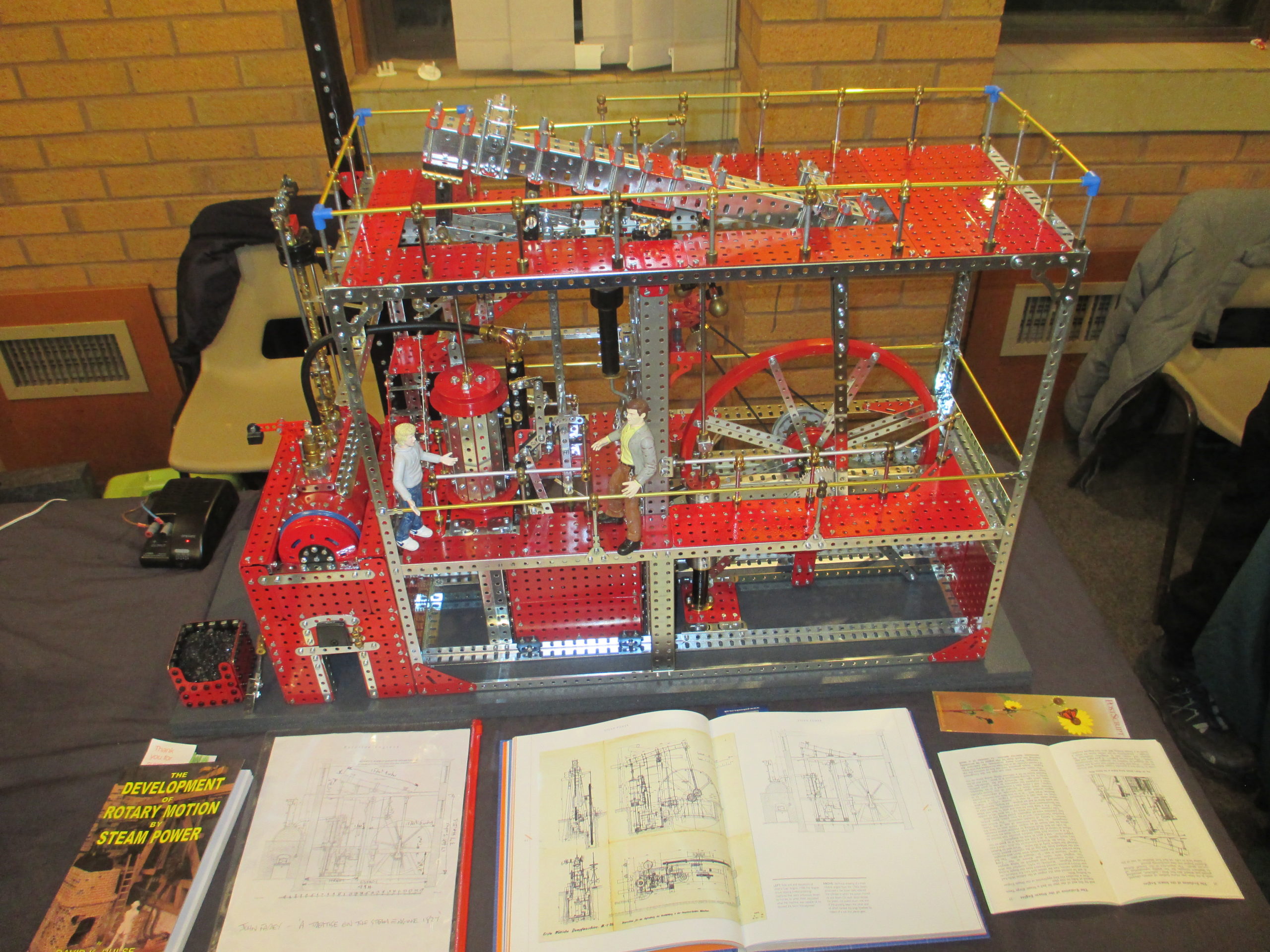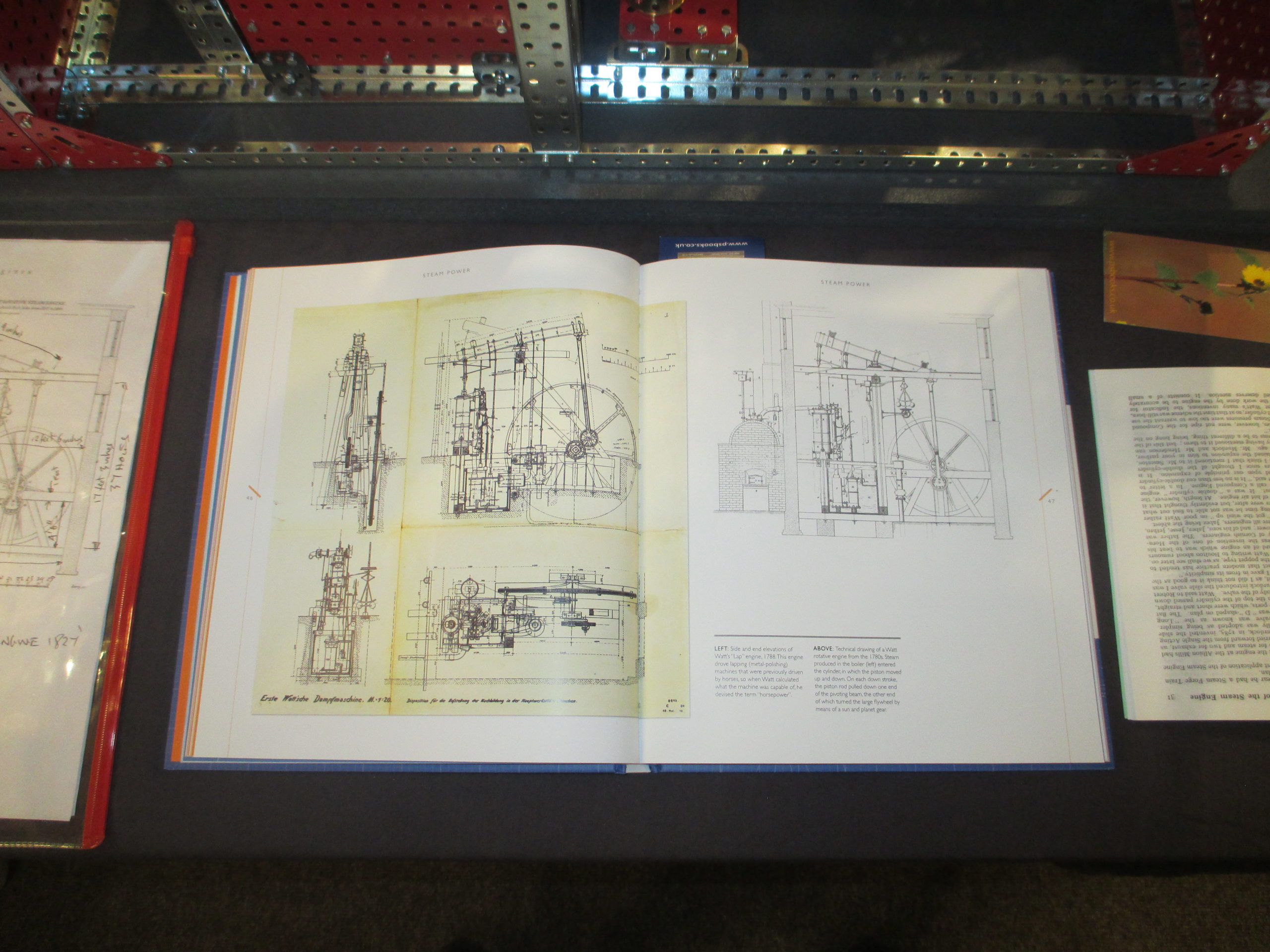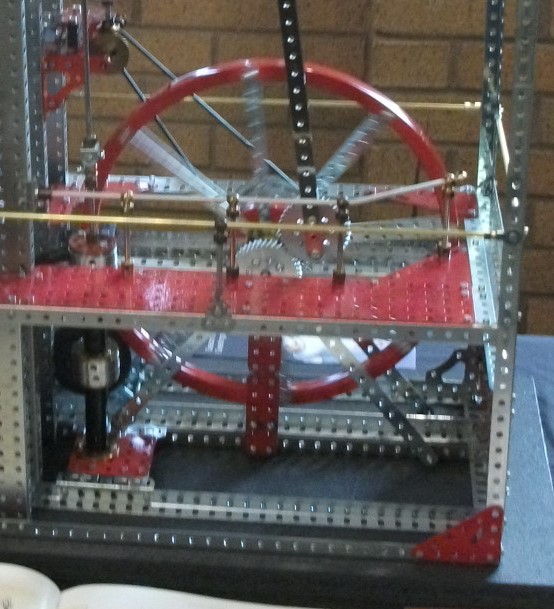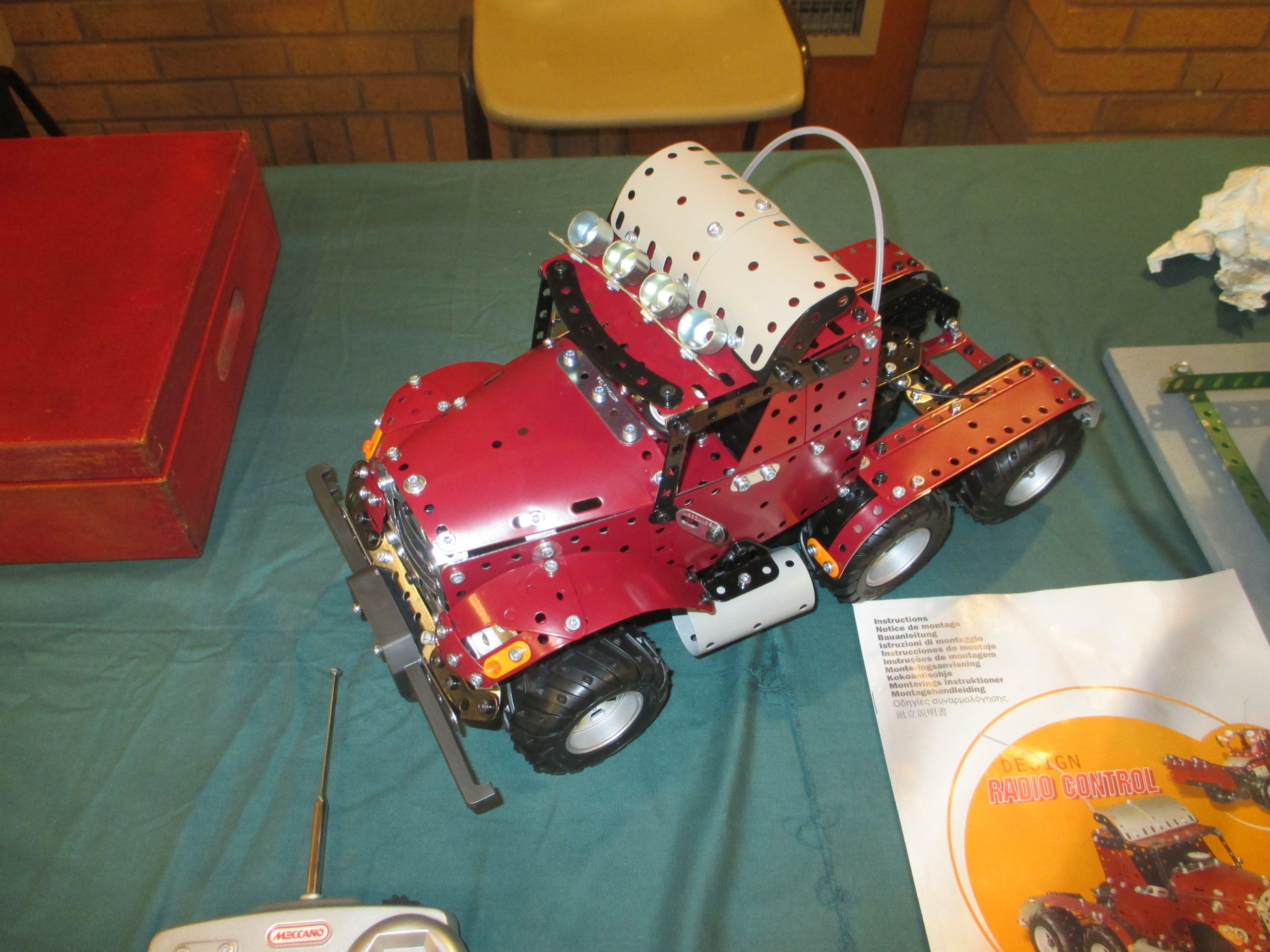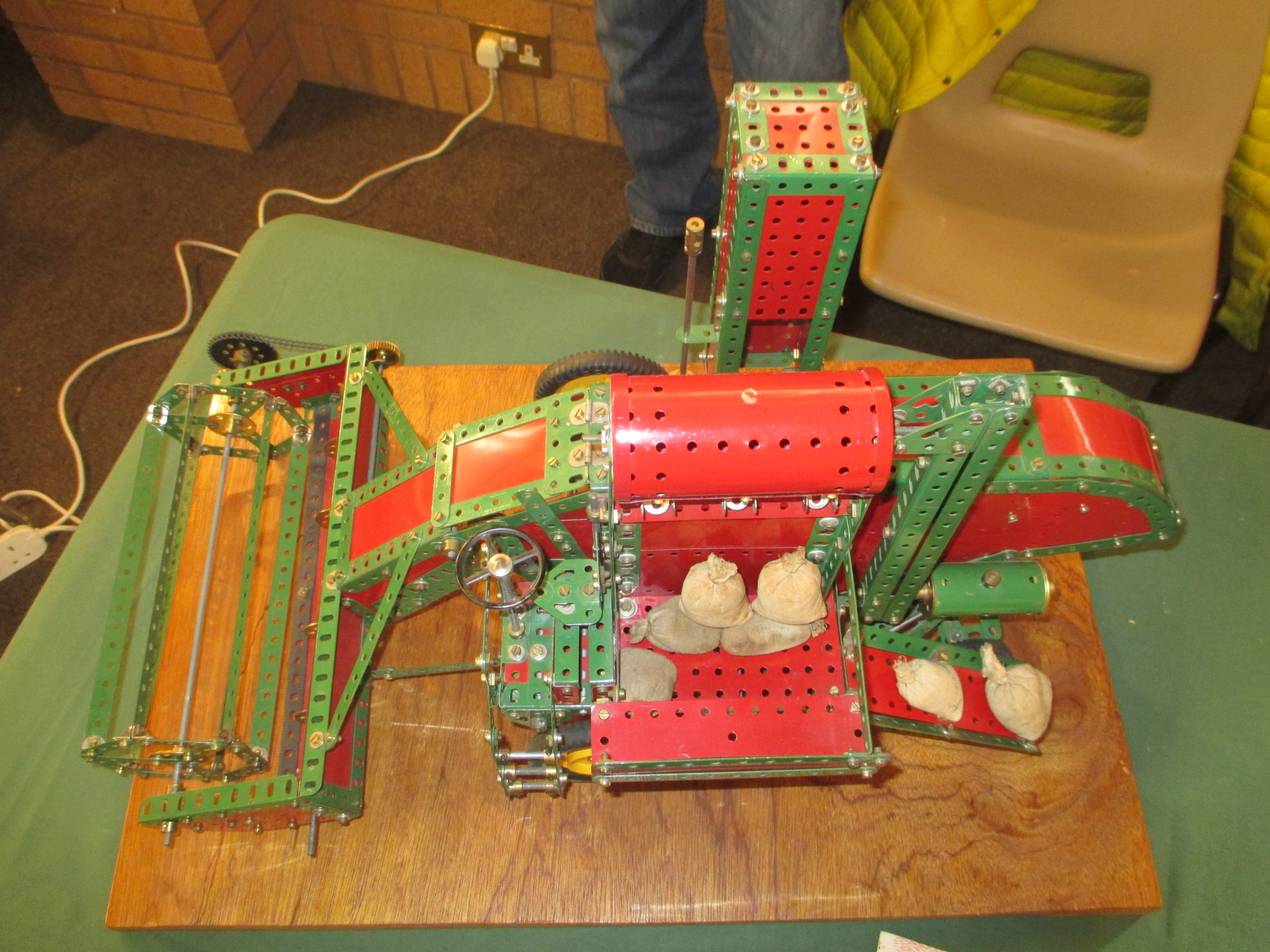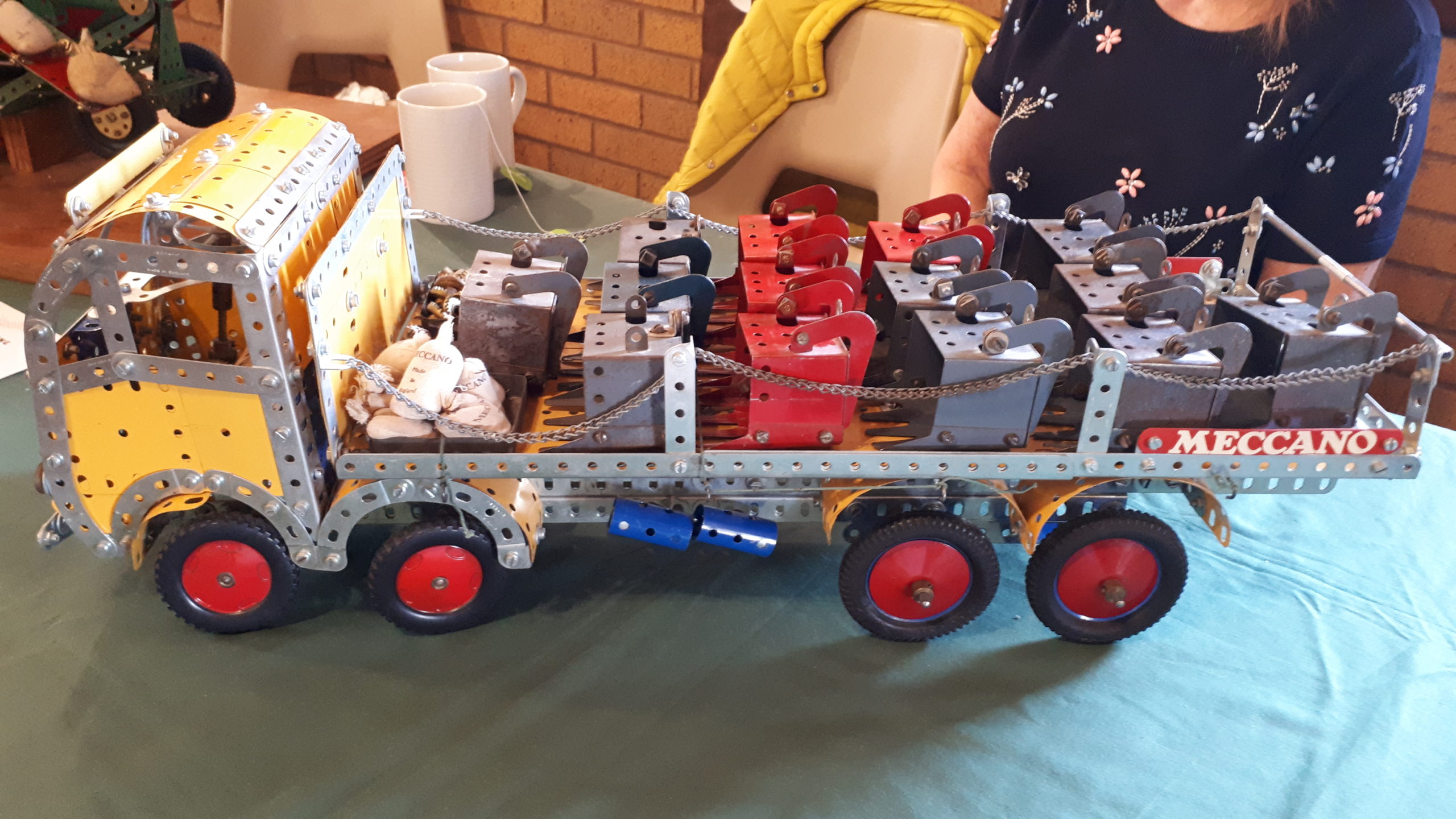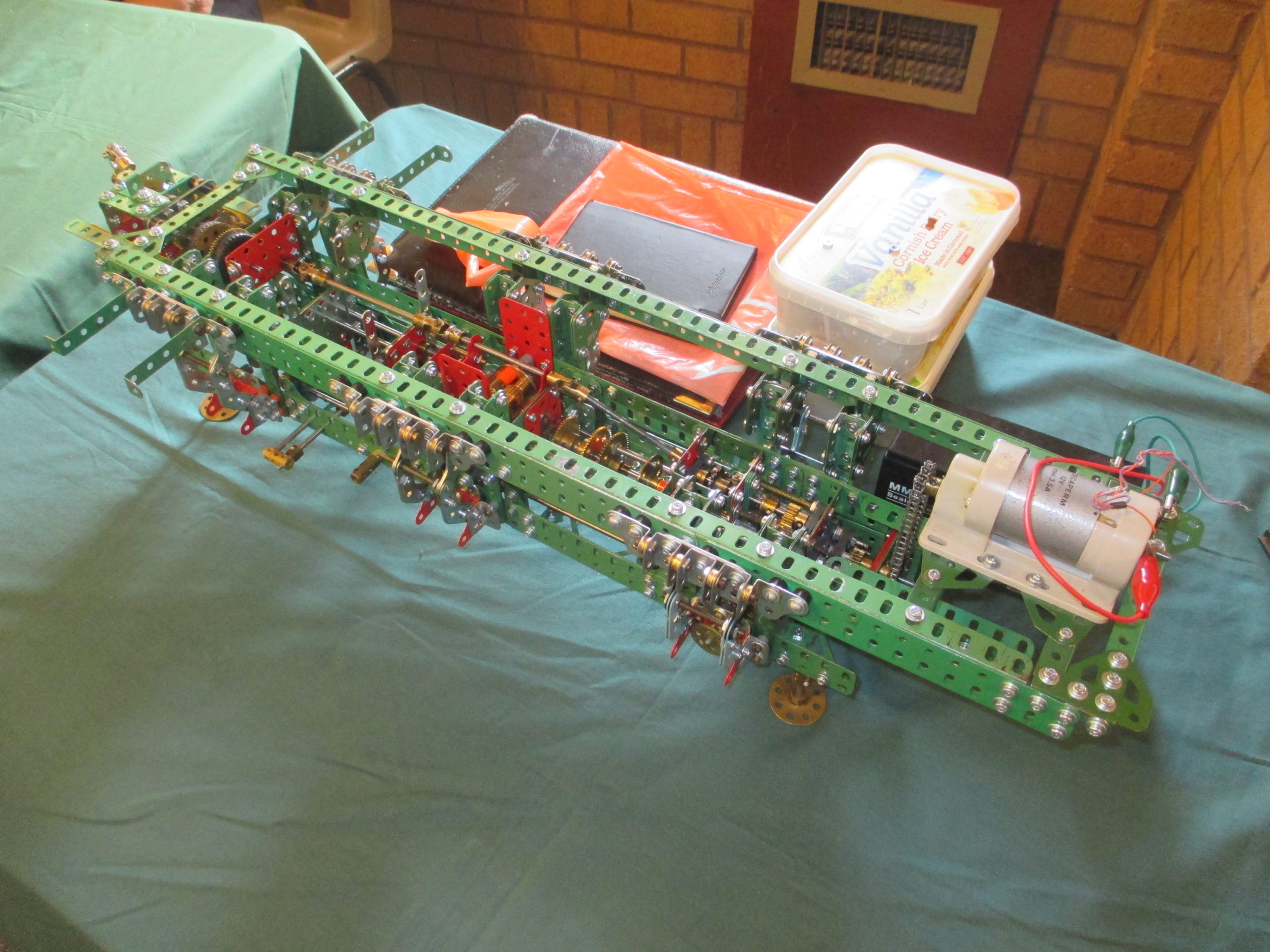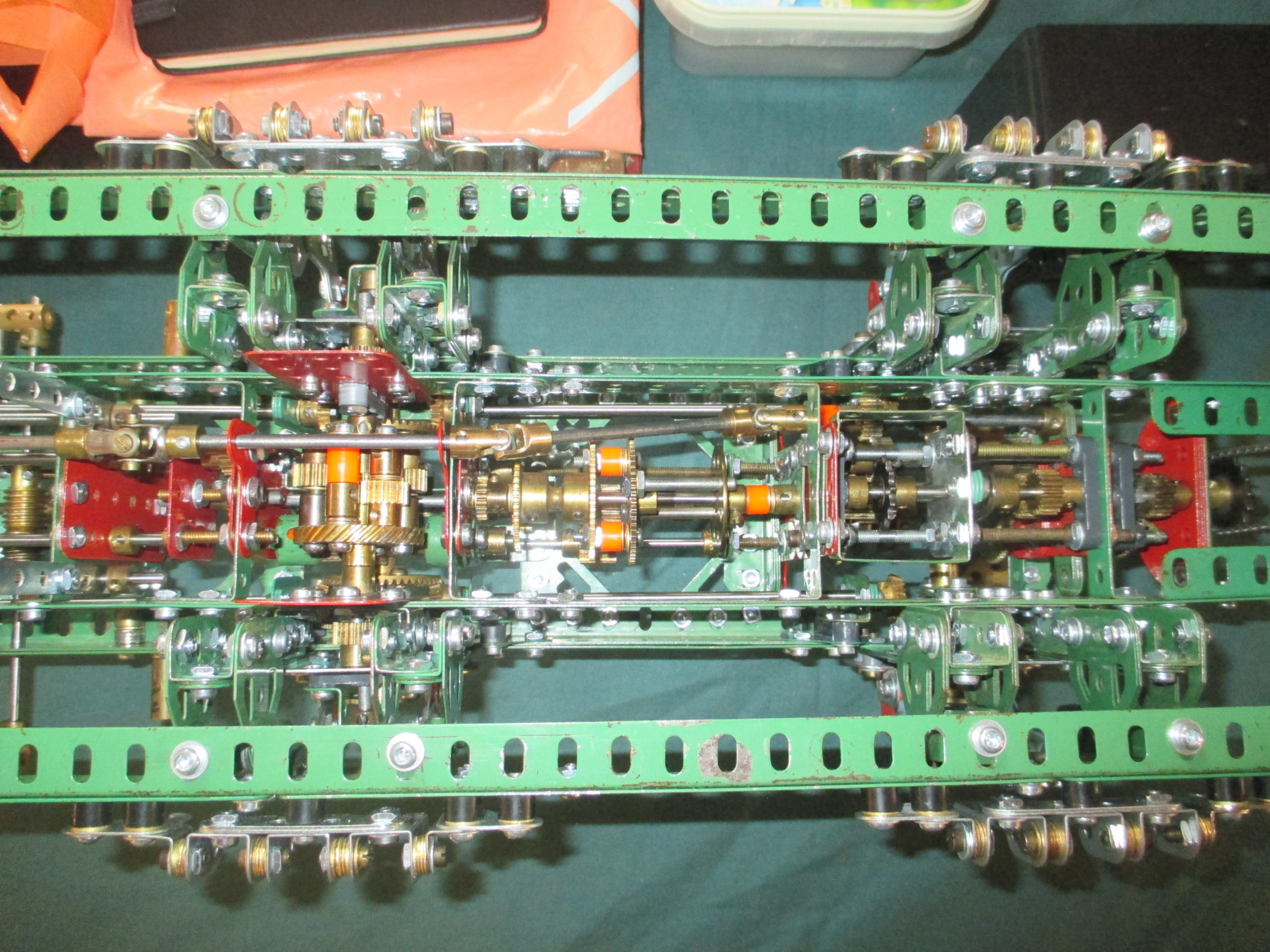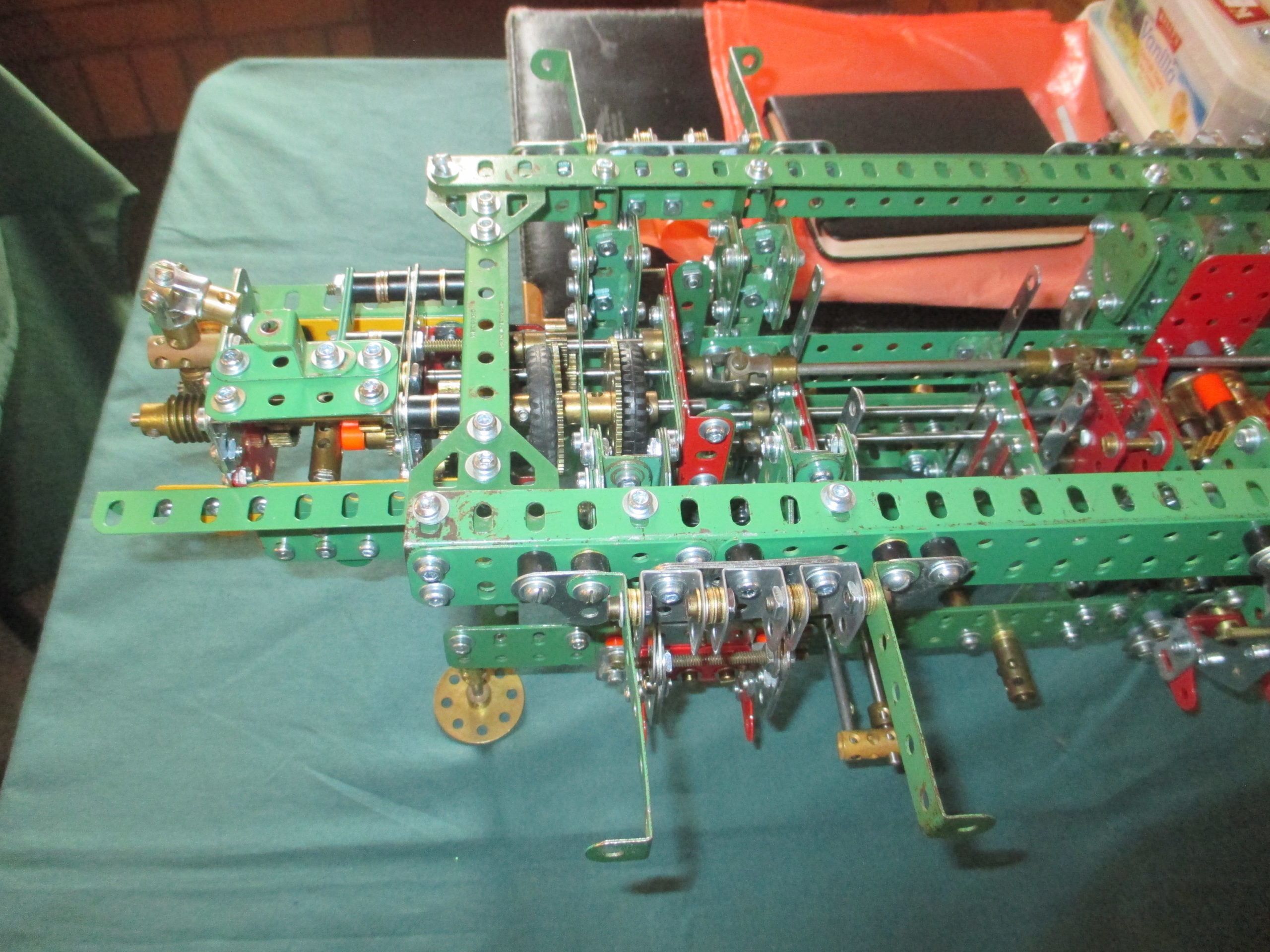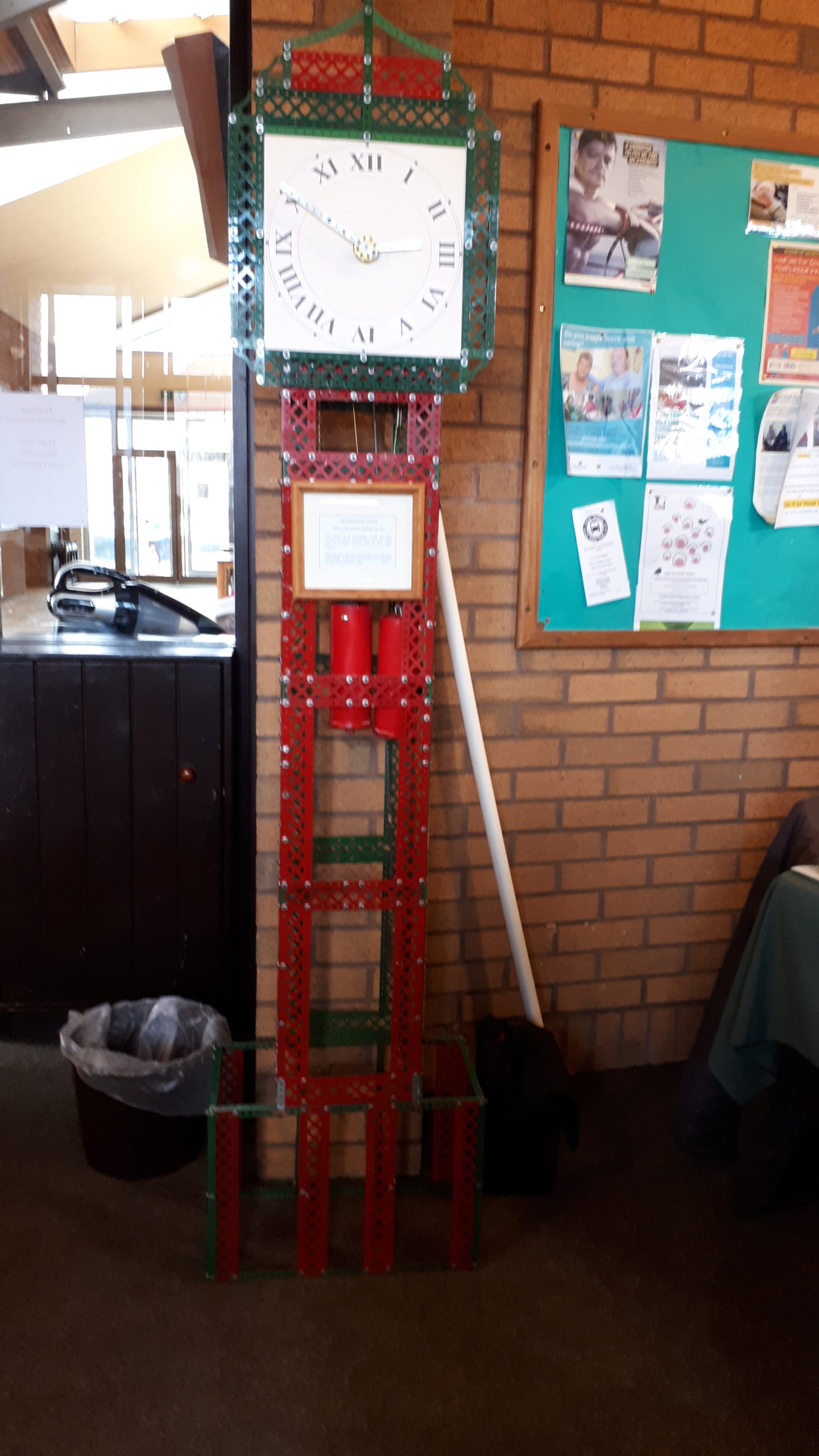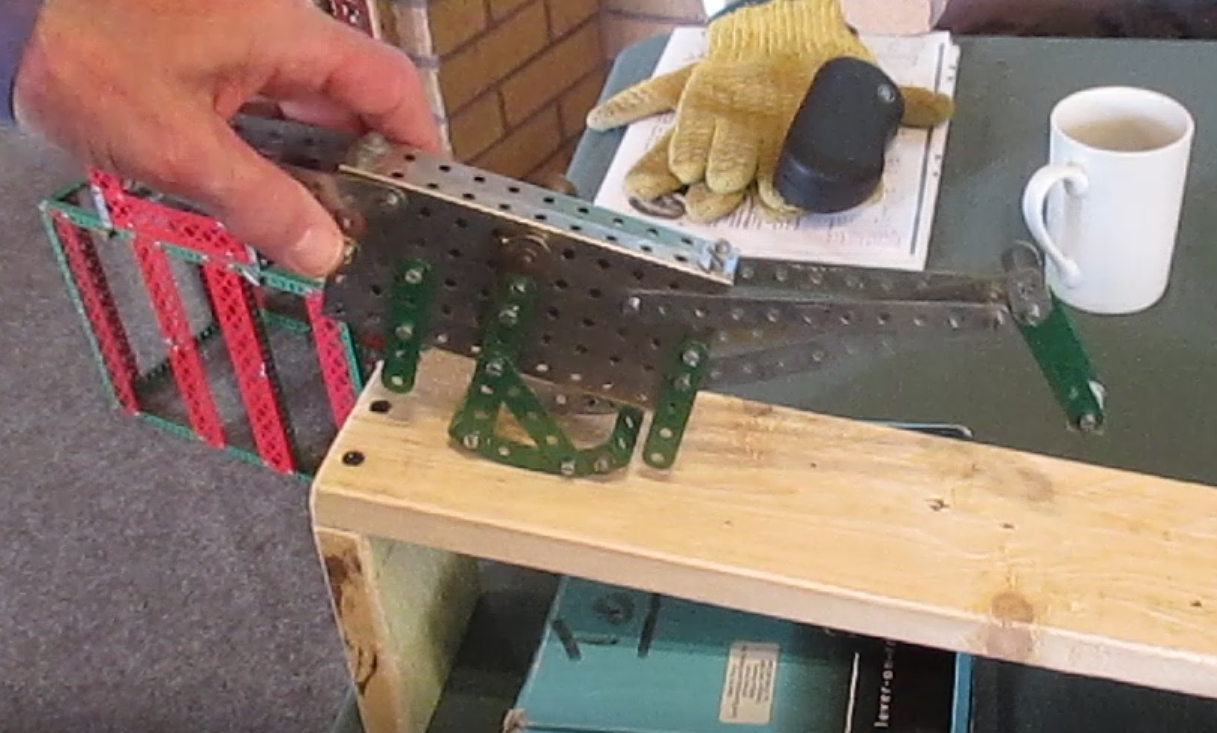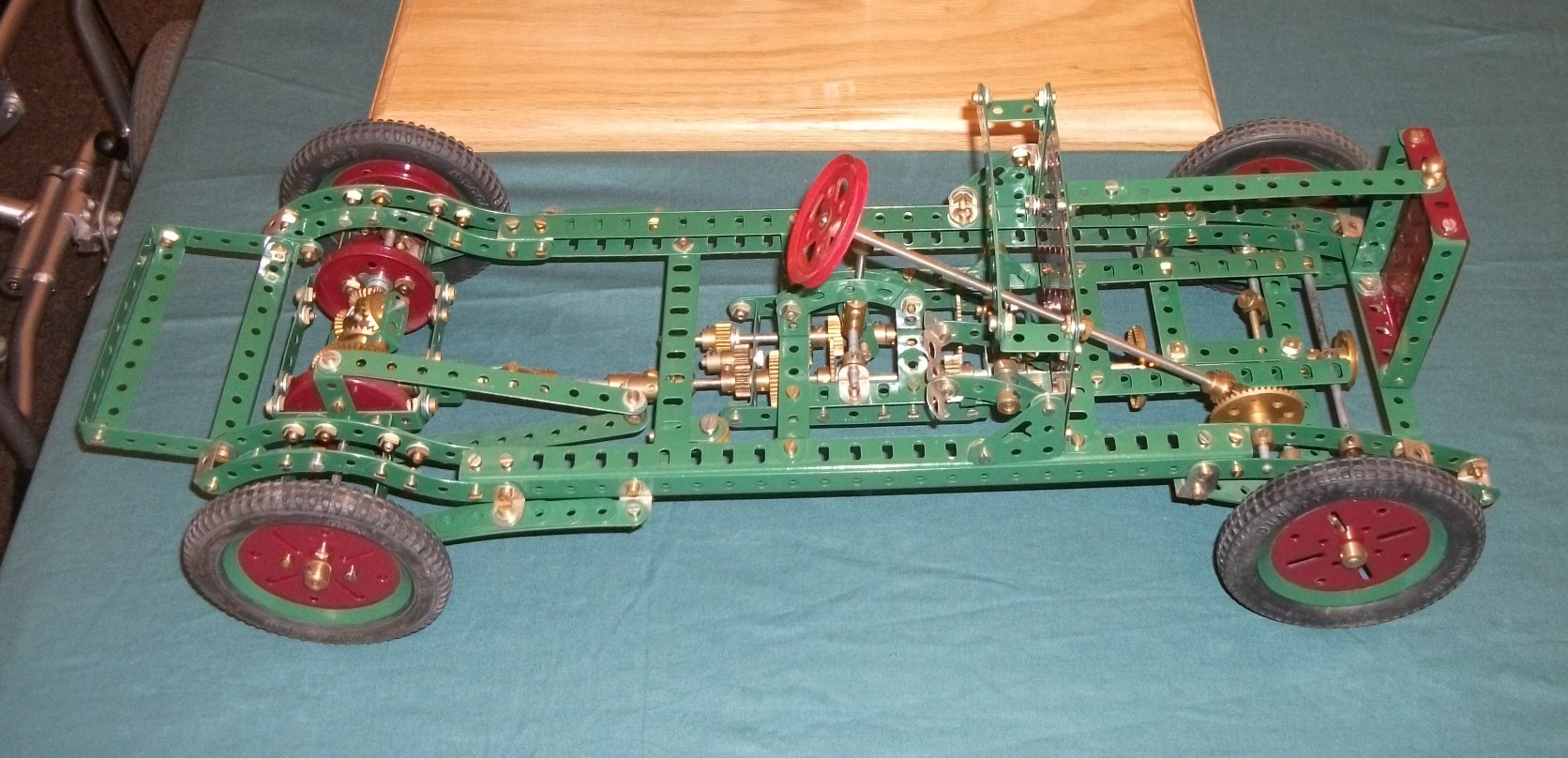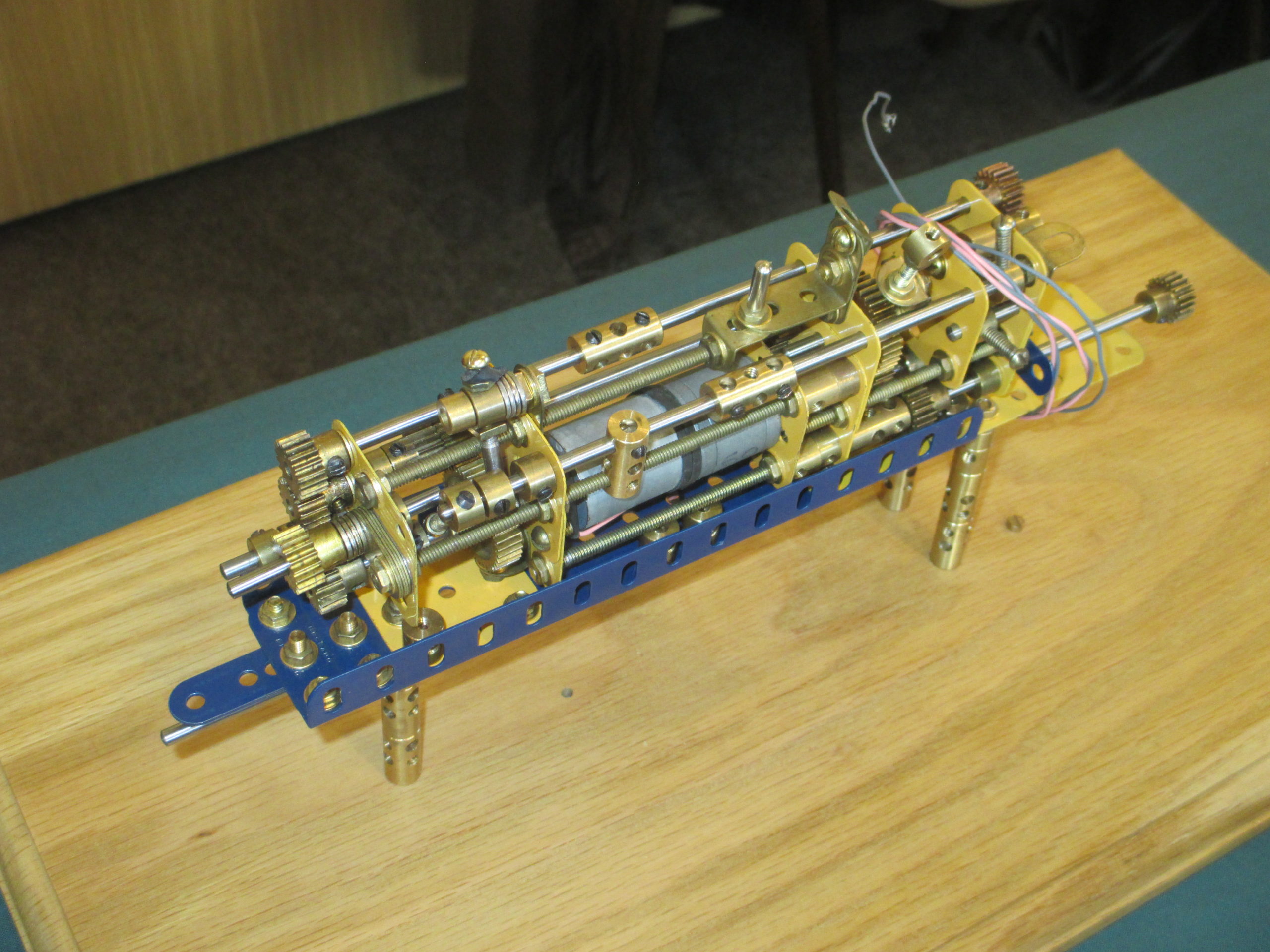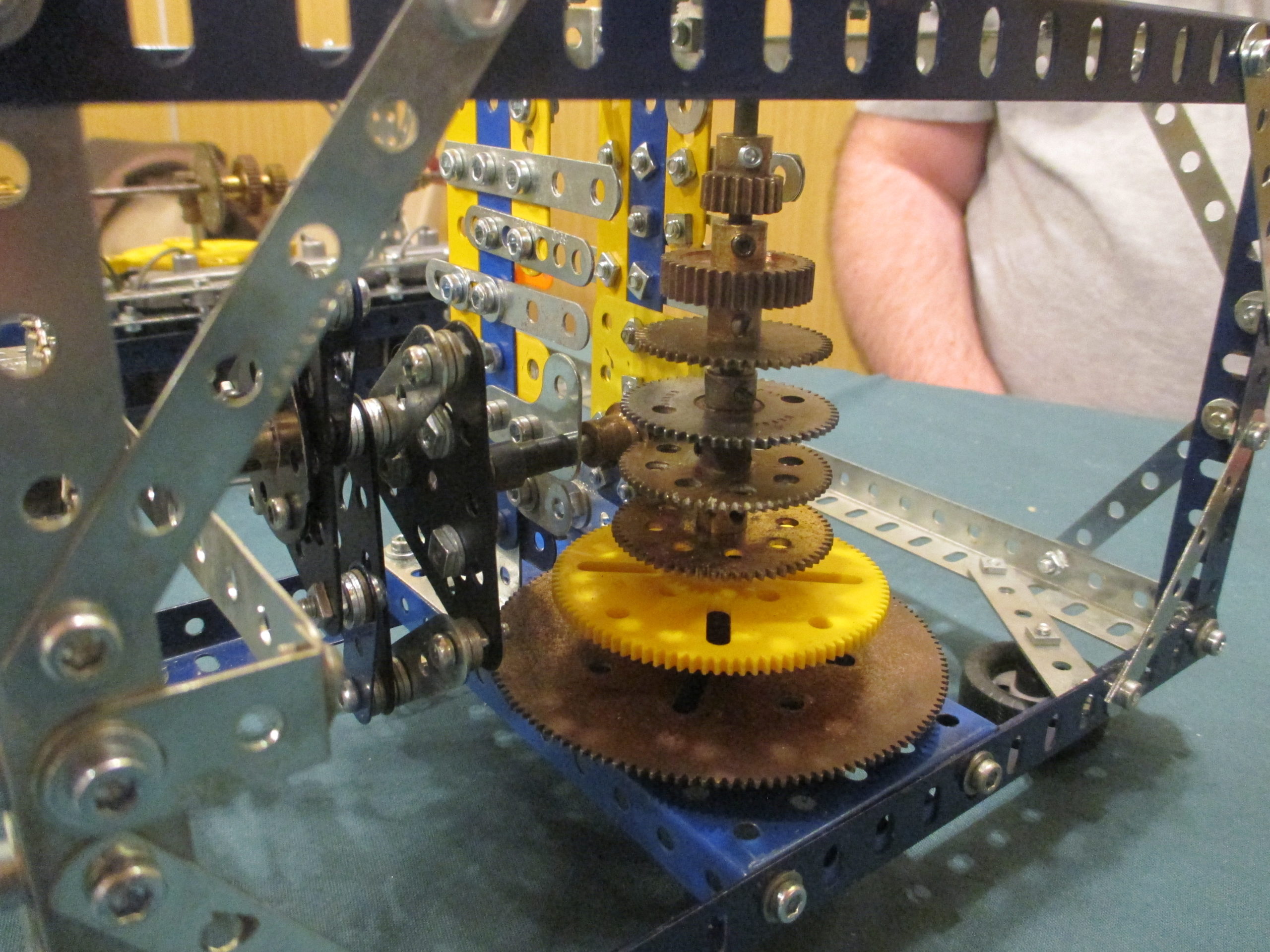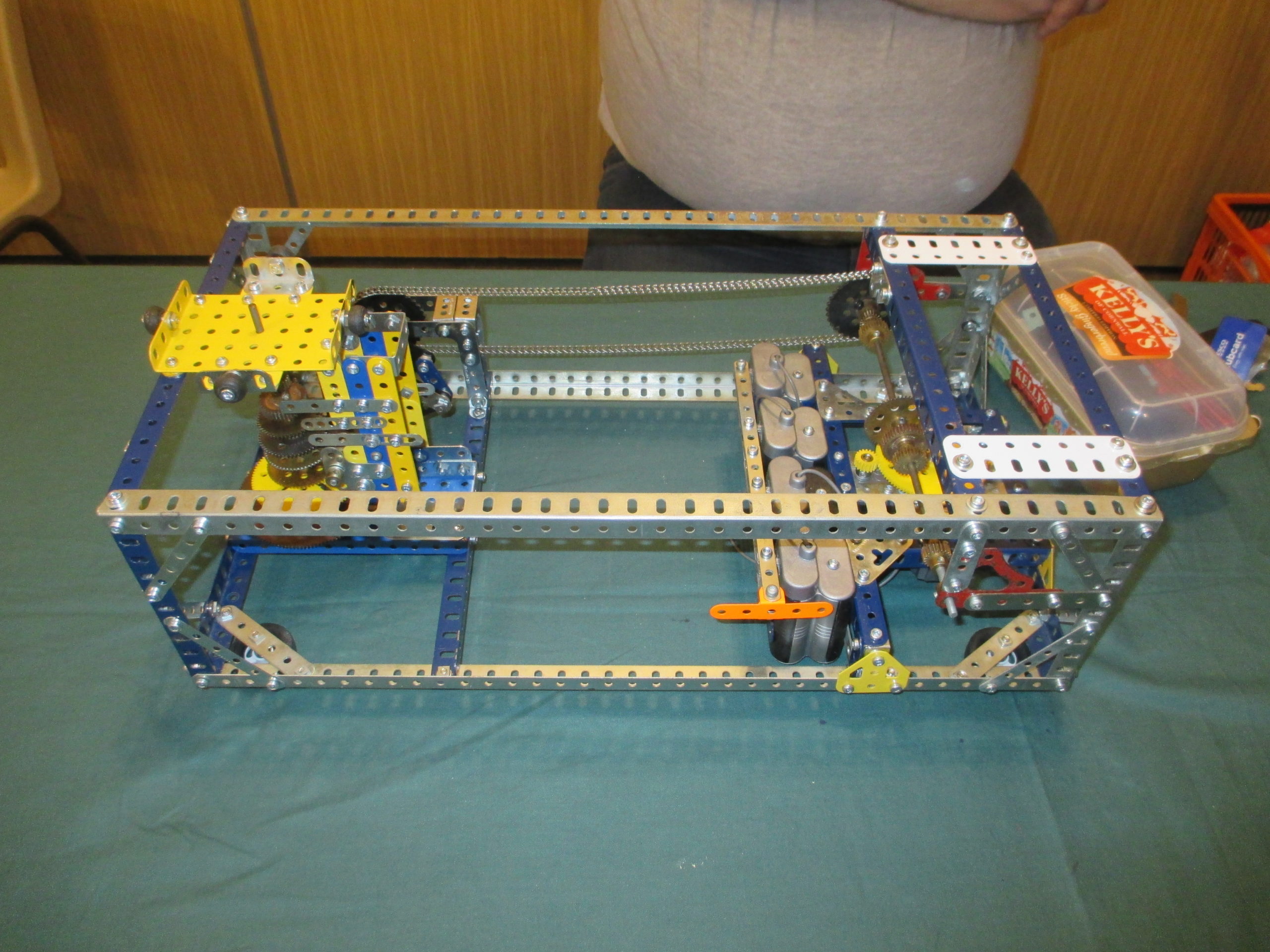Our first meeting of the year was held at Christ The King Church in Bradley Stoke and was very well attended despite the Six Nations being on the tv - 21 members and 4 guests. This included two new members - Chris and Mike - displaying for the first time with us. Other members attended this lively meeting without displaying a model.
Thanks to Dianne for the delicious cakes and freshly made sandwiches and grateful thanks to Pam and Sylv for their help with laying out the food and washing up.
Below are photos and descriptions of most of the models that were on display.
A short video of some of the moving models may be seen on YouTube.
John Day brought three models. This was the last time that he will show his fire engine hydraulic lift, which won The Malcolm Hanson Trophy in 2017, as it is now going to be dismantled.
It was the first showing of his Fairground 'Spider' ride. The four carriages rose and fell over the track nicely.
Lastly from John, was a model inspired by one he saw at Skegex last year, which was ping-pong ball kicker (sorry no photo yet). A recirculating number of ping-pong balls were kicked into a target chamber by a rotating club. This worked really well, but did require some modifications to the original to ensure that the balls did not bounce back out of the chamber. This was really pleasing to watch.
Meeting us for the first time, Chris Fearnley brought two models. The first was a drop handled racing bike. It should be noted that he has previously built a full size Meccano bike which can be seen on Chris Fearnley's Page but which has now been mostly dismantled, so this small version is a nod to one of his other pastimes.
His other model was a very nice 1/16th scale Triumph Herald. This was actually one he owned when he was 21, reflecting the correct colour scheme and even the sunroof he had. The plans for the chassis were found after an internet search and were originally produced by Roland Jaggard. Chris had a go at building the bodywork, but got stuck so it sat on the shelf for a while. He has since had another go at it and it now looks the part. If the weight was also to scale the car would be twice as heavy as it should be!
Andrew Jefferis displayed a horse and cart as per instructions from the March 1965 Meccano Magazine. As is often the case, there were mistakes in the plan and the model also needed a weight on the front of the horse to keep it grounded. It was powered by a Meccano clockwork motor which drove the horse to walk forward quite convincingly.
The horse can be seen walking in the video below as well or in the video of some of the moving models.
If you have ever wondered how those tall tower cranes are erected, well here's one method that's used. This model by Ian Henwood is a self erecting tower crane which does it all at the single push of a button. Apparently the secret to success is in the geometry of the ties. Ian worked purely from some sketches he made when viewing one of these cranes and reverse engineered the mechanism. During building it became apparent that each section was too heavy to work properly so he engineered a lighter solution whilst still maintaining stiffness. This can be seen in the video of some of the moving models or a sped up version below (thanks to Rob Briancourt).
Greg Worwood brought a 1/12th scale model of an early Boulton & Watt Rotary Steam Engine as installed at the Albion Flour Mill in London. Construction started in 1786 and was finished in 1788. The mill engine performed to the entire satisfaction of James Watt and was so successful it processed 16,000 bushels of wheat in 6 days which was enough for the weekly consumption of 150,000 people.
The engine incorporates Watt's parallel motion and Murdoch's sun and planet gear that achieves the rotary motion without using a traditional crank. The fate of the mill was to burn down! Perhaps it was too efficient for people's liking. This model was to have been built by John Wilson from Sheffield, but aged 85 his eyes are not so good, so Greg undertook to build the model for him. It will be taken for display to Telford and Ironbridge.
Greg's other model was a plastic Meccano fairground ride picked up from a charity shop. The kit was so poorly designed he had no choice but to produce his own version.
Martin Arnold brought his beam engine, previously displayed in July 2019.
His other model was again a lifting shovel which is now on its 5th iteration finally operating to Martin's satisfaction. Now constructed in red and green it incorporates two motors instead of a single E15R. A Meccano power drive motor operates the shovel and a more modern motor drives the wheels. A differential still needs to be added but space for this is tight.
Barry Winslow had a number 2 storage box from the early 1930's filled with the appropriate red and green parts from the period. He mentioned that he also has a number 3 storage box, and that he is looking for a number 1 to complete the set.
Pete Evans encouraged Barry to build something, so he is making a beam engine like Martin's but in red and green. He has already built the modern radio controlled lorry kit which he brought to display. Having done this he did mention that he actually enjoys collecting more than building. We think this is fine as he is keeping the history of Meccano alive with his collection.
Pete Evans brought a beautiful red and green 'Locomotion number 1'. The real loco was the first steam locomotive to haul a passenger carrying train on a public railway, the Stockton and Darlington Railway. It was built in 1825 but suffered an exploded boiler on 1st July 1828 at Aycliffe Lane Station, resulting in the death of its driver, John Cree.
Richard Gilbert is a collector rather than a builder, but nevertheless displayed two models. The Massey Ferguson Combine Harvester is from the set 10 plan number 13 from the 1950's based on the M-F 780 self propelled machine.
Chris Bates continues with his part-work build of an Alvis Stalwart Truck as published in quarterly parts in the Sheffield Meccano Guild Journal. Among other duties this truck used to supply shells to tanks on the Plains. The model still awaits the six large wheels which will be driven through a central differential, then out to the three wheels on each side. This driving arrangement is ok in a straight line or on soft ground but not so good on the road during cornering as the tyres scrub and produce torque wind-up.
The next assembly to be done is the gearbox for the crane operation which will need 47 of the 19-tooth pinions. Currently, the power steering mechanism is operational which utilises a friction clutch to engage power to the rack.
David Miller has a large 'O' Gauge railway in his attic, and this Meccano gantry crane complements his layout for loading and unloading containers from the trucks. It has been built with a crank handle for children to use.
New member Mike Morris displayed a contra-rotating double ferris wheel built from a picture in a magazine. It is operated by a single crank handle at its base and was an instant hit with his young granddaughter. He was somewhat concerned with the noise it made during transport and with the loose nuts and bolts found in the car boot.
The last time Alan Perry displayed his magnificent grandfather clock it refused to keep good time. However the exact same clock worked perfectly and kept excellent time throughout the meeting. He also brought a delightful little model of a kangaroo which skipped down a gentle slope. This can also be seen in the video of some of the moving models.
The Meccano Concorde has always been a good looking model but Steve Briancourt decided to make it a little more realistic and robust. The fuselage cylinders have been joined together using no. 63 couplings instead of the flat strip as supplied in the kit. This was to eliminate the problem of the cylinders being distorted when tightening the bolts, as the couplings maintained the cylinders' curvature when tightened. Down the centre of the fuselage is a long flat strip bolted to the underside of the couplings, resulting in a much stiffer fuselage.
The wing tips were curved down as per the real aircraft and wing attachment angle brackets were given a curved leg to match the fuselage profile.
Steve's other item was the beginnings of a new model based on the arcade 'Penny Falls' machine (like Tipping Point on TV) as demanded by his family! Seen here is a potential linear roller bearing design for the oscillating table. Getting a smooth motion of the table is the key to success in this model. Each bearing element comprises collars in a guide to form a near frictionless roller bearing.
Rob Curling's Vertical Twin Beam Pumping Engine has been improved a little after alterations to the Watt's parallel linkage. The deviation at the piston rod is now down to about 1/32nd of an inch by his estimation.
Richard Smith's SM no. 1 vehicle chassis was on display. Although the steering works he said it always presents a problem for this model. There is still more work to be done including fitting seats.
Mounted on a nice wooden plinth, Richard also showed the inner workings of his 1950's tractor. This gearbox transmits drive to all the functions. The plan is being given by Richard to The Midlands Meccano Guild to publish and sell for their club funds.
Neil Bedford fancied the idea of a rocking boat sitting in a moving wave scene. He had previously seen one made by George Illingworth. Neil's model is still in the early stages of build. It is his own take on the 'Cockleshell Hero' story of a daring kayak-based commando raid during WW2. This can also be seen in the video of some of the moving models.
The main mechanism is very loosely based on one by Tony Parmee, with a wave simulation of his own design. This currently comprises two cranks at the front running at different speeds. He hopes to have two commandos paddling the canoe now that he has a taste for movable figures. He sees this becoming one of those models which might sit on the back-burner for a while and 'eventually' get finished.
Neil also brought his 1930’s Morgan 3-wheel car – as shown before – his own version of the Meccano 1930’s blue & gold paint scheme with a modern Meccano motor driving the single rear wheel, 6 volt battery power, working steering and front suspension.
Kevin Harris is currently building a Meccanograph of his own design. In particular, it features a stack of gears in diminishing size which can be individually selected to engage with the drive from the motor. This gives the opportunity to change the motion of the paper table.
He has very appropriately used a Schmidt coupling to accommodate the varying shaft spacing between the worm gear drive and the gear stack output. The drive comprises four modern Meccano motors ganged around a 95-tooth gear to provide the necessary torque. A chain drive transmits this to the Schmidt coupling. This is one of six models Kevin has on the go at the moment.
